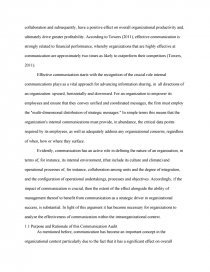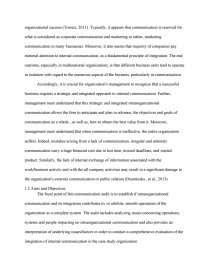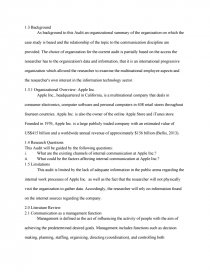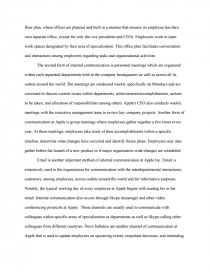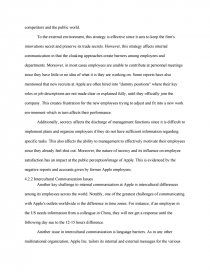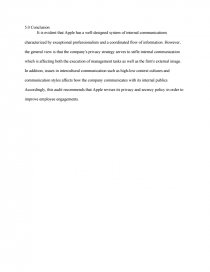Strategic Audit
Essay by wakesho • January 21, 2014 • Research Paper • 3,181 Words (13 Pages) • 2,007 Views
Abstract
Management, is a universal business phenomenon, whose main role is to direct numerous individual efforts towards a fixed purpose in all organizations. This paper speaks to the fact that among the core functions of management is the process of communication. Therefore, the objective of this paper is to investigate through a case study, the vital prominence of internal communication as an essential component of organization management. Primarily, special emphasis is accorded to efficient internal communication, as an element that is vital and significant for the development, management and efficient functioning of any company. Additionally, this paper underscores another key aspect of effective internal communication, as a key prerequisite for creating a good external communication or public relations.
1.0 Introduction
The success of any organization hinges on the way the firm communicates with its internal stakeholders mainly its employees. Indeed, employees are the face of a company and have the capacity to "sell" to the organization's external stakeholders on numerous levels as long as they have clear information and accurately understand their company's goals and objectives. Notably, where employees have insight into the organizational strategy and development plans, they are more engaged as they are able to understand how their distinctive role contributes significantly, to the organization's success. Accordingly, employee engagement augments collaboration and subsequently, have a positive effect on overall organizational productivity and, ultimately drive greater profitability. According to Towers (2011), effective communication is strongly related to financial performance, whereby organizations that are highly effective at communication are approximately two times as likely to outperform their competitors (Towers, 2011).
Effective communication starts with the recognition of the crucial role internal communications plays as a vital approach for advancing information sharing, in all directions of an organization: upward, horizontally and downward. For an organization to empower its employees and ensure that they convey unified and coordinated messages, the firm must employ the "multi-dimensional distribution of strategic messages." In simple terms this means that the organization's internal communications must provide, in abundance, the critical data points required by its employees, as well as adequately address any organizational concerns, regardless of when, how or where they surface.
Evidently, communication has an active role in defining the nature of an organization, in terms of, for instance, its internal environment, (that include its culture and climate) and operational processes of, for instance, collaboration among units and the degree of integration, and the configuration of operational undertakings, processes and objectives. Accordingly, if the impact of communication is crucial, then the extent of the effect alongside the ability of management thereof to benefit from communication as a strategic driver in organizational success, is substantial. In light of this argument it has become necessary for organizations to analyze the effectiveness of communication within the intraorganizational context.
1.1 Purpose and Rationale of this Communication Audit
As mentioned before, communication has become an important concept in the organizational context particularly due to the fact that it has a significant effect on overall organizational success (Towers, 2011). Typically, it appears that communication is reserved for what is considered as corporate communication and marketing or rather, marketing communication in many businesses. Moreover, it also seems that majority of companies pay minimal attention to internal communication, as a fundamental principle of integration. The end outcome, especially in multinational organizations, is that different business units tend to operate in isolation with regard to the numerous aspects of the business, particularly in communication.
Accordingly, it is crucial for organization's management to recognize that a successful business requires a strategic and integrated approach to internal communication. Further, management must understand that this strategic and integrated intraorganizational communication allows the firm to anticipate and plan in advance, the objectives and goals of communication as a whole , as well as, how to obtain the best value from it. Moreover, management must understand that when communication is ineffective, the entire organization suffers. Indeed, mistakes arising from a lack of communication, irregular and untimely communication carry a huge financial cost due to lost time, missed deadlines, and wasted product. Similarly, the lack of internal exchange of information associated with the work/business activity and with the all company activities may result in a significant damage to the organization's external communication or public relation (Dzamtoska , et al., 2013).
1.2 Aims and Objectives
The focal point of this communication audit is to establish if intraorganizational communication and its integration contributes to, or inhibits, smooth operations of the organization as a complete system. The audit includes analyzing issues concerning operations, systems and people impacting on intraorganizational communication and also provides an interpretation of underlying issues/factors in order to conduct a comprehensive evaluation of the integration of internal communication in the case study organization.
1.3 Background
As background to this Audit an organizational summary of the organization on which the case study is based and the relationship of the topic to the communication discipline are provided. The choice of organization for the current audit is partially based on the access the researcher has to the organization's data and information, that it is an international progressive organization which allowed the researcher to examine the multinational employee aspects and the researcher's own interest in the information technology sector.
1.3.1 Organizational Overview: Apple Inc.
Apple Inc., headquartered in California, is a multinational company that deals in consumer electronics, computer software and personal computers in 408 retail stores throughout fourteen countries. Apple Inc. is also the owner of the online Apple Store and iTunes store. Founded in 1976, Apple Inc. is a large publicly traded company with an estimated value of US$415 billion and a worldwide
...
...

